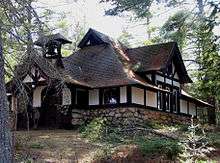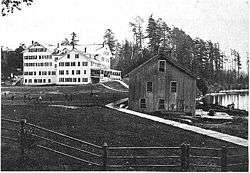Brighton, Franklin County, New York
| Brighton, Franklin County, New York | |
|---|---|
| Town | |
|
Brighton Town Hall, Benjamin A. Muncil, 1914 | |
 Brighton Location within the state of New York | |
| Coordinates: 44°26′27″N 74°13′56″W / 44.44083°N 74.23222°WCoordinates: 44°26′27″N 74°13′56″W / 44.44083°N 74.23222°W | |
| Country | United States |
| State | New York |
| County | Franklin |
| Government | |
| • Type | Town Council |
| • Town Supervisor | John Quenell (D) |
| • Town Council |
Members' List
|
| Area | |
| • Total | 83.0 sq mi (215.0 km2) |
| • Land | 77.9 sq mi (201.7 km2) |
| • Water | 5.1 sq mi (13.2 km2) |
| Elevation | 1,880 ft (573 m) |
| Population (2010) | |
| • Total | 1,435 |
| • Density | 18/sq mi (7.1/km2) |
| Time zone | Eastern (EST) (UTC-5) |
| • Summer (DST) | EDT (UTC-4) |
| FIPS code | 36-08213 |
| GNIS feature ID | 0978752 |
| Website |
townofbrighton |
Brighton is a town in Franklin County, New York, United States. The population was 1,435 at the 2010 census.[1] It was named after Brighton, England, by early surveyors in the region.
The town is in the southern part of the county and is inside the Adirondack Park. Paul Smith's College is in the community of Paul Smiths, a hamlet of Brighton.
History
The first settlers in this area arrived around 1815. The town of Brighton was set aside from the Duane in 1858. James M. Wardner was elected its first supervisor. Apollos "Paul" Smith arrived in 1859 and gradually built up a hotel in the community that bears his name. Having become an important Adirondack hotel, Paul Smith's College was established by his family. The college now uses the land where the hotel once stood along Lower St. Regis Lake. Also around that time James Wardner had a small hotel on Rainbow Lake.
Among the "second round" of settlers in the town of Brighton after its pioneers Follensby, S. Johnson, the Rice brothers, Amos and Levi; Oliver Keese and Thomas A. Tomlinson; James and Seth Wardner, were the Ricketsons, the Rands, the Dustins, Jute Q. King and his son, Philemon King. They were scattered along the highway from Keese Mill and McColloms to Paul Smiths to Easy Street to the Split Rock Road and to Rainbow Lake and Jones Pond.
The hamlet now called Gabriels originated back when only the Rands, the Ricketsons, the Dustins, and the Otises were settled on farms nearer to the Split Rock Road and Ricketson Brook in the southern part of the town along the boundary with the town of Harrietstown than where Gabriels is currently situated. It wasn't until the Adirondack & St. Lawrence Railway came in 1892 that Gabriels expanded northward, with many settling near the railroad station. Following the arrival of the railroad, the Sisters of Mercy came to the town and established a tuberculosis sanitorium, and Muncil's sawmill was founded. Paul Smith's Hotel immediately started a stage line to the railroad station. The Gabriels Sanatorium, opened in 1897, later became Camp Gabriels, a minimum-security state prison.
The Brighton Town Hall was designed and built by Benjamin A. Muncil in 1914. Muncil was a talented local builder who also designed and built Marjorie Merriweather Post's Camp Topridge, and White Pine Camp, which was used as a summer White House of US President Calvin Coolidge. It was listed on the National Register of Historic Places in 2003.[2]
Geography

Brighton is located south of the center of Franklin County within the limits of the Adirondack Forest Preserve. According to the United States Census Bureau, the town has a total area of 83.0 square miles (215.0 km2), of which 77.9 square miles (201.7 km2) is land and 5.1 square miles (13.2 km2), or 6.15%, is water.[1] The majority of the town consists of woodlands, lakes, streams and ponds (both publicly and privately owned), with a few areas of developed hamlets and farmland (privately owned). Major water bodies include Upper and Lower St. Regis Lake in the southwest corner of town.
New York State Route 30 is a north-south highway in the town and intersects New York State Route 86 at Paul Smiths. NY 30 leads north 32 miles (51 km) to Malone, the Franklin County seat, and southwest 26 miles (42 km) to Tupper Lake. NY 86 leads southeast 12 miles (19 km) to Saranac Lake.
Demographics
| Historical population | |||
|---|---|---|---|
| Census | Pop. | %± | |
| 1860 | 208 | — | |
| 1870 | 204 | −1.9% | |
| 1880 | 267 | 30.9% | |
| 1890 | 480 | 79.8% | |
| 1900 | 706 | 47.1% | |
| 1910 | 741 | 5.0% | |
| 1920 | 684 | −7.7% | |
| 1930 | 993 | 45.2% | |
| 1940 | 804 | −19.0% | |
| 1950 | 962 | 19.7% | |
| 1960 | 1,092 | 13.5% | |
| 1970 | 1,473 | 34.9% | |
| 1980 | 1,625 | 10.3% | |
| 1990 | 1,511 | −7.0% | |
| 2000 | 1,682 | 11.3% | |
| 2010 | 1,435 | −14.7% | |
| Est. 2014 | 1,436 | [3] | 0.1% |

As of the census[5] of 2000, there were 1,682 people, 319 households, and 203 families residing in the town. The population density was 21.6 people per square mile (8.3/km²). There were 591 housing units at an average density of 7.6 per square mile (2.9/km²). The racial makeup of the town was 79.37% White, 18.55% African American, 0.65% Native American, 1.19% Asian, and 0.24% from two or more races. Hispanic or Latino of any race were 0.48% of the population.
There were 319 households out of which 34.5% had children under the age of 18 living with them, 53.9% were married couples living together, 5.0% had a female householder with no husband present, and 36.1% were non-families. 29.2% of all households were made up of individuals and 9.1% had someone living alone who was 65 years of age or older. The average household size was 2.46 and the average family size was 3.04.
In the town the population was spread out with 11.7% under the age of 18, 37.5% from 18 to 24, 29.8% from 25 to 44, 15.5% from 45 to 64, and 5.4% who were 65 years of age or older. The median age was 26 years. For every 100 females there were 215.0 males. For every 100 females age 18 and over, there were 246.2 males.
The median income for a household in the town was $42,679, and the median income for a family was $48,250. Males had a median income of $35,952 versus $26,250 for females. The per capita income for the town was $11,995. About 3.0% of families and 6.2% of the population were below the poverty line, including 5.3% of those under age 18 and 8.7% of those age 65 or over.
Communities and locations in Brighton


- Easy Street – A hamlet east of Paul Smiths on NY-86. It is also known as "Paul Smiths Easy Street."
- Gabriels – A hamlet in the southeast part of the town, located on NY-86 at the junction of County Road 30, the site of Camp Gabriels, a former minimum security state prison.
- Jones Pond – A lake north of Gabriels.
- Keese Mill – A hamlet west of Paul Smiths.
- Lower St. Regis Lake – A lake south of Paul Smiths where Paul Smith's College is located.
- McCollums – A hamlet in the northwest part of the town on NY-30.
- Meacham Lake – A lake partly in the town at the north town line.
- Osgood Pond – A lake northeast of Paul Smiths.
- Osgood River – A stream flowing toward Macomber Lake past McCollums.
- Paul Smiths – A hamlet in the south part of the town on NY-30.
- Rainbow Lake – (1) A hamlet near the east town line, north of Gabriels on County Road 60, and (2) A lake at the east town line near the community of Rainbow Lake.
- Spitfire Lake – A lake south of Lower St. Regis Lake.
- Upper St. Regis Lake – A lake at the south town line.
References
- 1 2 "Geographic Identifiers: 2010 Census Summary File 1 (G001), Brighton town, Franklin County, New York". American FactFinder. U.S. Census Bureau. Retrieved June 10, 2016.
- ↑ National Park Service (2010-07-09). "National Register Information System". National Register of Historic Places. National Park Service.
- ↑ "Annual Estimates of the Resident Population for Incorporated Places: April 1, 2010 to July 1, 2014". Retrieved June 4, 2015.
- ↑ "Census of Population and Housing". Census.gov. Archived from the original on May 11, 2015. Retrieved June 4, 2015.
- ↑ "American FactFinder". United States Census Bureau. Archived from the original on 2013-09-11. Retrieved 2008-01-31.
Further reading
- Brighton Architectural Heritage Committee, 2002. Brighton 2000: Life in the Town of Brighton, Franklin County, New York in the year 2000, Brighton Architectural Heritage Committee, Paul Smiths, NY, 153 pp. (Available on CD).
- Collins, Geraldine, 1977. The Brighton Story, North Country Books, Lakemont, NY, 202 pp., incl. bibliography.
- Kudish, Dr. Michael, 1975. A Preliminary Vascular Flora of the Paul Smiths-Saranac Lake Area, The Adirondacks, New York, With Notes on the Climate, Geology, and Soils, Paul Smith's College, Paul Smiths, NY.
- Kudish, Dr. Michael, 1981. Paul Smiths Flora II: Additional Vascular Plants, Bryophytes (Mosses and Liverworts), Soils and Vegetation, Local Forest History, Paul Smith's College, Paul Smiths, NY.
- Kudish, Dr. Michael, 1992. Adirondack Upland Flora, The Chauncy Press, Saranac Lake, N.Y., 316 pp. (In this work, Dr. Kudish, a forest ecologist, brings together all the factors leading to why it is certain plants, trees, bushes grow where they do, in a way understandable to the layman. While applicable to the whole Adirondack Park, Dr. Kudish made extensive use of the town of Brighton and the surrounding area.)
- Kudish, Dr. Michael, 2004. Historical Update: Paul Smith's College Lands, Forests, and Buildings 1981 to 2004, Paul Smith's College, Paul Smiths, NY, 76 pp., incl. index. (Contains much information about the Town of Brighton)
- "Town of Brighton Smart Growth Plan", 9 July 2009, prepared by F.X. Browne, Inc., Saranac Lake, NY., 36 pp. (incl. biblio), six appendices provide supporting information.
- Wardner, Charles A., 2010. Footprints & Sunset on Adirondack Trails: The Memoirs of James Manchester Wardner 1831-1904, privately published by Joan Wardner Allen, printed by Graphics North, Jay, NY.

